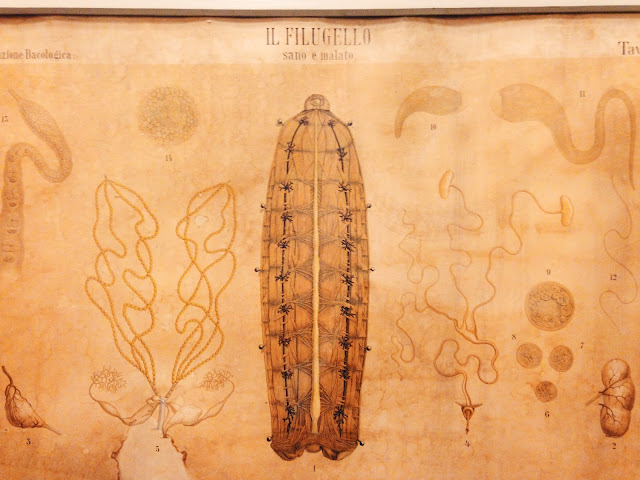 |
| the silkworm museum - Museo del Baco da Seta in Vittorio Veneto |
how do you feel about small museums? I know, they can be a real bummer - a junk jumble in two rooms for 10 euros - OR they can represent a genuine chance to learn something about the history and peculiarity of the region you're visiting. or, in this particular case, of the town you're living in.
Marco and I visited the
silkworm museum {
Museo del Baco da Seta} of
Vittorio Veneto back in april. we had been aware of this museum exhistence for a long time, but it's easier to delay a visit to the closest places, isn't it?
 |
| large antique animal and botanical prints are hanging on the museum's wall |
silk farming has spread in this area of Veneto in the late nineteenth century. in 1930 Treviso province became the leading producer in Italy with 5.500.000 kg of cocoons. during those years, the most part of the population living in Vittorio Veneto area had been concerned by the breeding of silkworms until a recent past. our grandparents still remember the soft noise coming from the kitchen, made by hundreds of silkworms (in the local dialect they called them "cavalier") eating mulberry leaves.
 |
| silken cocoons |
 |
| work in the silk factory was mainly female |
 |
silk factory memorabilia: different breed of silkworms produces cocoons of different colors: from pure white (the finest), to pale yellow and even light orange (less valuable)
|
 |
| silk factory memorabilia: advertising poster and a pupation register |
silk production was distributed between silkworms breeding farms, local farming families and spinning mills. every breeding farm {there were one dozen of them only in Vittorio Veneto} carefully chose a few local families were the silkworms were nurtured for weeks.
silkworms eat every 3-4 hours. when they are one week old, 20.000 silkworms need 10 kg of mulberry leaves. 28 days later, they'll need 600 kg. that's why mulberry trees characterized the landscape of this area, together with the cultivation of cereals and vine. due to their value, the mulberry tree shadow used to be called "golden shadow".
the silkworms needed to stay in a warm, clean and well ventilated enviroment. farming families usually keep them in the kitchen, but more worms meant more money, so also barns and attics could go.
sericulture had a strong impact on people lives, before declining in the late '60s and 70's up to disappear completely from the region. just some mulberry trees here and there and former breeding farms and silk mills which are now used for something else still remain. so, the most interesting feature of this small museum: it tells the soon-to-be forgotten stories of thousands of men and women who lived in this area.
 |
| former silkworms genetic center in Vittorio Veneto. it closed on 1978. I pass it almost everyday, now i look at it with different eyes. |














:) i want to go there!
ReplyDeleteyes please! oh, wouldn't it be wonderful ♥
Delete